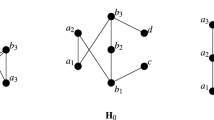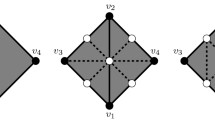Abstract
In this paper we combine ideas from tolerance orders with recent work on OC interval orders. We consider representations of posets by unit intervals Iv in which the interval endpoints (L(v) and R(v)) may be open or closed as well as the center point (c(v)). This yields four types of intervals: A (endpoints and center points closed), B (endpoints and center points open), C (endpoints closed, center points open), and D (endpoints open, center points closed). For any non-empty subset S of {A, B, C, D}, we define an S-order as a poset P that has a representation as follows: each element v of P is assigned a unit interval Iv of type belonging to S, and x ≺ y if and only if either (i) R(x) < c(y) or (ii) R(x) = c(y) and at least one of R(x), c(y) is open and at least one of L(y), c(x) is open. We characterize several of the classes of S-orders and provide separating examples between unequal classes. In addition, for each S ⊆{A, B, C, D} we present a polynomial-time algorithm that recognizes S-orders, providing a representation when one exists and otherwise providing a certificate showing it is not an S-order.
Similar content being viewed by others
References
Bogart, K.P., Fishburn, P.C., Isaak, G., Langley, L.: Proper and unit tolerance graphs. Discrete Appl. Math. 60, 99–117 (1995)
Dourado, M., Le, V., Protti, F., Rautenbach, D., Szwarcfiter, J.L.: Mixed unit interval graphs. Discrete Math. 312, 418–429 (2012)
Fishburn, P.C.: Intransitive indifference with unequal indifference intervals. J. Math. Psych. 7, 3357–3363 (1970)
Fishburn, P.C.: Interval Orders and Interval Graphs: A study of partially ordered sets. Wiley, New York (1985)
Gimbel, J.G., Trenk, A.N.: On the weakness of an ordered set. SIAM J. Discrete Math. 11, 655–663 (1998)
Golumbic, M.C., Trenk, A.N.: Tolerance Graphs. Cambridge University Press, Cambridge (2004)
Joos, F.: A characterization of mixed unit interval graphs. J. Graph Theory 79, 267–281 (2015)
Le, V., Rautenbach, D.: Integral mixed unit interval graphs. Discrete Appl. Math. 161, 1028–1036 (2013)
Rautenbach, D., Szwarcfiter, J.L.: Unit interval graphs of open and closed intervals. J. Graph Theory 72, 418–429 (2013)
Scott, D., Suppes, P.: Foundational aspects of theories of measurement. J. Symbolic Logic. 23, 113–128 (1958)
Shuchat, A., Shull, R., Trenk, A.N.: Range of the fractional weak discrepancy function. Order 23, 51–63 (2006)
Shuchat, A., Shull, R., Trenk, A.N.: The fractional weak discrepancy of a partially ordered set. Discret. Appl. Math. 155, 2227–2235 (2007)
Shuchat, A., Shull, R., Trenk, A.N.: Unit interval orders of open and closed intervals. Order 33, 85–99 (2016)
Shuchat, A., Shull, R., Trenk, A.N., West, L.: Unit mixed interval graphs. Congressus Numerantium 221, 189–223 (2014). arXiv:1405.4247
Trenk, A.N.: On k-weak orders: recognition and a tolerance result. Discrete Math. 181, 223–237 (1998)
Acknowledgements
We appreciate the valuable suggestions made by the referees that improved the algorithm and the clarity of the paper.
Author information
Authors and Affiliations
Corresponding author
Additional information
The third author’s work was supported by a Simons Foundation grant (#426725, Ann Trenk).
Appendix
Appendix
In Example 3.5 we showed that the posets 2 + 2, 3 + 1, 4 + 1, V, and Z are positioned correctly in the Venn diagrams of Figs. 4 and 5. In this appendix, we provide proofs for the remaining posets that appear in those figures.
The poset 3 + 1 + 1.
This poset has the forcing cycle \({\mathcal C}: x \prec y \prec z \parallel u \parallel x \prec y \prec z \parallel v \parallel x\) with \(val({\mathcal C}) = 0\). Suppose 3 + 1 + 1 were an S-order and without loss of generality fix an S-representation \(\mathcal I\) of it in which all intervals have length 2 and c(x) = 0. Now Theorem 3.3 implies that c(y) = 1, c(z) = 2, c(u) = 1, c(v) = 1. There are three unit intervals with center at 1, thus if |S| ≤ 2, two of these intervals must be identical. Identical intervals result in twins, so the poset 3 + 1 + 1 can not be induced in any twin-free S-order when |S| ≤ 2.
We also consider cases where |S| = 3. A representation is possible if S = {A, C, D}, namely by making Ix, Iy, Iz of type C, Iu of type A and Iv of type D, and if S = {A, B, C}, namely by making Ix, Iu, Iz of type A, Iy of type B and Iv of type C. However, an S-representation is not possible for S = {B, C, D}, as we now show. Since u ∥ z and v ∥ z, by Remark 2.4, we know neither Iu nor Iv can be of type B, so without loss of generality, Iu is type C and Iv is type D. Now if Iz is type B or C we get v ≺ z, a contradiction, and if Iz is type D we get u ≺ z, a contradiction.
The poset H.
This poset has the forcing cycle \({\mathcal C}: x \prec y \prec z \prec w \parallel u \parallel v \parallel x\) with \(val({\mathcal C}) = 0\). Suppose H were an S-order for some S. Without loss of generality, fix an S-representation \(\mathcal I\) of it which all intervals have length 2 and c(x) = 0. Now Theorem 3.3 implies that c(y) = 1, c(z) = 2, c(w) = 3, c(u) = 2, and c(v) = 1. By choosing Iy and Iz to be type B and the remaining intervals to be type A, we get an AB-representation of H.
By Remark 2.4, intervals Ix, Iw, Iu, Iv cannot be of type B. If no intervals are type B, then without loss of generality, Ix, Iy, Iz, Iw are all of type C and because y ≺ u and v ≺ z, this forces Iu, Iv also to be of type C, a contradiction. If no interval is of type A, without loss of generality, Ix is of type C, forcing Iy, Iz, Iw to also be of type C, and then it is not possible to assign a type to Iu because y ≺ u and u ∥ w. Thus H has an S-representation if and only if {A, B}⊆ S.
The poset Y.
We show that poset Y is an S-order for S = {A, B, C} but not when S = {A, C, D} or {B, C, D}, nor for any S with |S| ≤ 2. The same is true of its dual.
Poset Y has the forcing cycle \({\mathcal C}: x \prec y \prec z \parallel v \parallel x \prec y \prec w \parallel v \parallel x\) with \(val({\mathcal C}) = 0\). Suppose Y were an S-order for some S. Without loss of generality, fix an S-representation \(\mathcal I\) of it which all intervals have length 2 and c(x) = 0. Now Theorem 3.3 implies that c(y) = 1, c(z) = 2, c(w) = 2, c(v) = 1.
A representation is possible if S = {A, B, C}, namely by making Ix, Iz, Iv, of type A, Iy of type B, and Iw of type C. If \(\mathcal I\) contains only intervals of type A and B, then Iz and Iw must be of type A by Remark 2.4, resulting in z and w being twins.
Now consider S = {A, C, D} and for a contradiction, assume an S-representation is possible. By Remark 2.4, intervals Iy, Iz, Iw must all be of type C or all of type D and each of these cases leads to Iz, Iw getting identical intervals. Similarly, if S = {B, C, D}, intervals Iv, Iw, Iz must be type C or D by Remark 2.4, but z and w are both incomparable to v, so they are forced to get identical intervals, a contradiction.
Finally, Y is not induced in a twin-free S order for |S| ≤ 2, since we have shown this to be true for S = {A, B} and each other such S is a subset of {B, C, D} or {A, C, D}.
The same is true of its dual.
The poset X 1.
This poset has the forcing cycle \({\mathcal C}: x \prec t \prec w \parallel y \parallel u \prec t \prec z \parallel v \parallel x\) with \(val({\mathcal C}) = 0\). Suppose X1 were an S-order for some S. Without loss of generality, fix an S-representation \(\mathcal I\) of it in which all intervals have length 2 and c(x) = 0. Now Theorem 3.3 implies that c(y) = 1, c(z) = 2, c(u) = 0, c(v) = 1, c(w) = 2, c(t) = 1.
An S-representation is possible for S = {B, C, D}, namely by making Ix, Iy, Iz of type C, Iu, Iv, Iw of type D, and It of type B. We show that X1 is not an S-order for any other S, |S| ≤ 3.
Note that the elements x, y, u, v induce a 2 + 2 in X1. As seen in Example 3.5, without loss of generality Ix, Iy are type C and Iu, Iv are type D. Since u ≺ t and v ≺ t, interval It must be type B.
The poset X 2.
This poset has the forcing cycle \({\mathcal C}: x \prec y \prec z \parallel t \parallel u \prec v \prec w \parallel t \parallel x\) with \(val({\mathcal C}) = 0\). Suppose X2 were an S-order for some S. Without loss of generality, fix an S-representation \(\mathcal I\) of it in which all intervals have length 2 and c(x) = 0. Now Theorem 3.3 implies that c(y) = 1, c(z) = 2, c(u) = 0, c(v) = 1, c(w) = 2, c(t) = 1.
An S-representation is possible for S = {A, C, D}, namely by making Ix, Iy, Iz type C, Iu, Iv, Iw type D, and It type A. We show that X2 is not an S-order for any other S, |S| ≤ 3.
As in the case of poset X1, the elements x, y, u, v induce a 2 + 2 in X2. Again, without loss of generality Ix, Iy are type C and Iu, Iv are type D. Since u ∥ t and x ∥ t, interval It must be type A.
The poset X 3.
The poset X3 contains both posets X1 and X2 and hence is not an S-order for |S| ≤ 3. A representation is possible for S = {A, B, C, D} by starting with the BCD-representation for X1 given above and introducing an additional interval, of type A, centered at 1.
Rights and permissions
About this article
Cite this article
Shuchat, A., Shull, R. & Trenk, A.N. Tolerance Orders of Open and Closed Unit Intervals. Order 36, 313–333 (2019). https://doi.org/10.1007/s11083-018-9468-1
Received:
Accepted:
Published:
Issue Date:
DOI: https://doi.org/10.1007/s11083-018-9468-1




